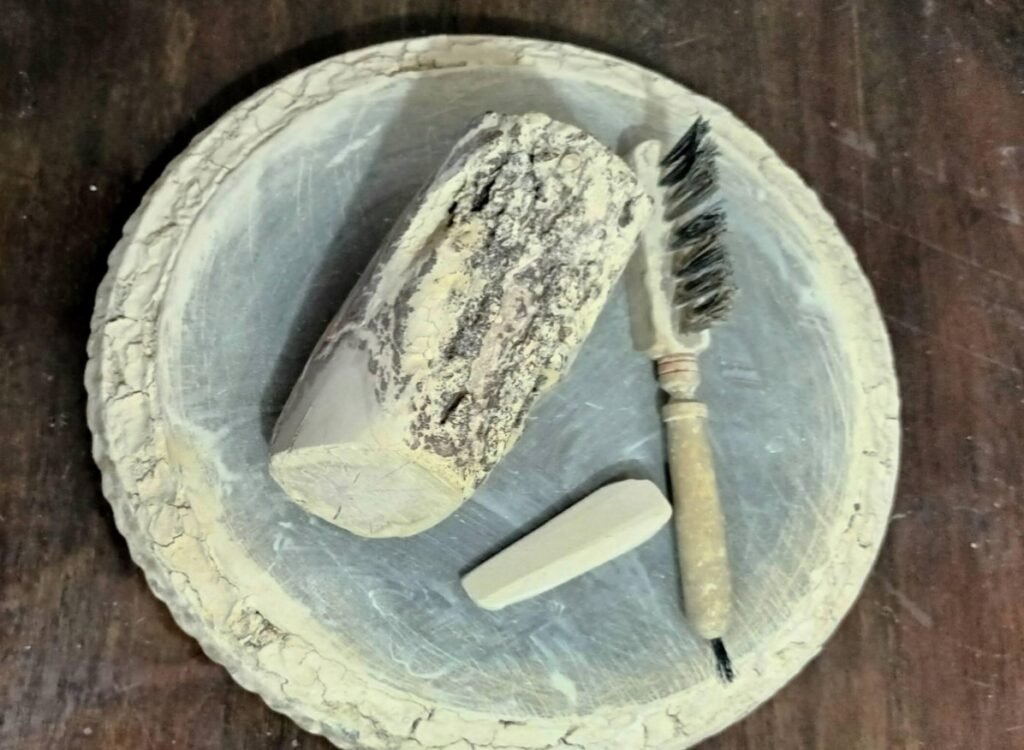When a foreigner sets foot in the land of Myanmar, one of the questions I’ve heard is “What is the yellow paste on the cheeks of young women?”
Well, it is “thanaka,” which can only be found in Myanmar.
To kindergarten with thanaka on my face
The first time I wore thanaka on my cheeks was when I went to kindergarten. It was actually one of my earliest memories. Back then, I didn’t care if I looked good or bad. I just let my mother do whatever she wanted with my appearance on my first day of school.
I can vaguely recall some facts, though. I remember how I sat still in front of a large mirror as my mom grinded a piece of tree bark that was bigger than the size of my small arm against a flat, heavy stone that had been wet with water. The magic took place after grinding for about two minutes; pure water was used, but after grinding, there was the yellow paste. Mom rubbed the yellow paste on the flat stone with her hand and put it on my cheeks, drawing oval forms to achieve an egg shape. That was it. There were no complaints from me, and I just happily went to school.
Peer pressure raised its ugly head
As I reached puberty, I started caring about how I looked. This means that I applied thanaka by myself and never let my mom help me because I realized how silly I looked when my mom put the yellow paste on my face. It was as if she was using her five fingers to paint an ugly sketch, with my face as a sketch paper. The result was like those markings on a tiger’s face.

During high school, I wore thanaka every day, and so did my peers. I wore a simple shape made using thanaka by putting the yellow paste all over my face and using a brush to draw lines carefully. My friends wore particular shapes such as a rectangle or leaf. The reason I wore thanaka 365 days a year, even when I was sick, was simply because my mom would convince me I needed to.
“A Burmese lady must not start her day with a bare face,” she would say. “Thanaka will keep your skin cool and brighten your face. Thanaka is good for your skin health.”
I do believe in these mantras. However, there was a period when I assumed thanaka was so cheap that it was used only by people who were considered poor. Personally, I consider the word “cheap” to mean not being able to blend in with classmates and teachers in this context.

On my university campus, a bunch of gorgeous ladies were part of my surroundings. Their beauty was reinforced by international beauty brands. As for me, who grew up with little knowledge of cosmetics from other countries, I felt like I was the least beautiful girl in the university. I can still remember some comments from my friends.
“There is thanaka on your eyebrows,” they’d say in between their laughs.
“Your thanaka looks funny on you,” they’d sometimes say, assuming a serious tone. Still, it was as if they were suppressing their laughter.
“Your thanaka is soaked with sweat.”
“There are only some spots of thanaka on your face and it doesn’t look good.”
“Thanaka is so cheap.”
“I’m too lazy to do the grinding part.”
I didn’t defend myself back then. I thought maybe they were right.
So I changed my style. I began to use foundation, blushes, and lipsticks that were recommended by my friends. I couldn’t pronounce the brand names, but they were probably made in Korea and Thailand. I spent my monthly pocket money on them instead of enjoying my favorite pork stick in Tutt-pi restaurant.
I thought my appearance changed for the better with the help of these cosmetics. I told myself that even if I didn’t attract the attention of boys, if I looked good in the eyes of female classmates, I would at least not be judged. That was until one moment when I looked at myself in the mirror one afternoon.
Using international beauty products, though expensive and made of rare ingredients, didn’t turn out well for me in the long run. I looked good with makeup in the morning but not in the afternoon and evening; I usually got soaked with too much sweat. Myanmar has very hot weather and the heat is especially unbearable in the afternoons. As a result, my face would get oily at noon and my skin wouldn’t react well to chemical ingredients.
At the end of the day, pimples and acne appeared on my forehead, cheeks, and even around my neck. I covered them by wearing an even thicker foundation and more makeup. No matter how hard I tried, the result was that the more I wore, the more pimples and acne appeared on my face. In the end, I had no option but to stop using makeup.
Welcoming thanaka back into my life
Although I stopped using foundation and other makeup, I began to use thanaka again since I was not comfortable with a bare face. That was also due to my mom’s nagging about how thanaka could heal those pimples. She had no proof, of course. It was just the power of a mother that convinced me. If I were to become the president of a thanaka company, I would give the lead position of marketing department director to my mom! She was that good.

In this case, my mom was right. After using thanaka, the result was quite impressive.
Thanaka kept my skin cool when the weather was too hot, so I didn’t feel the burning heat under my skin like I did with makeup. That might be because thanaka is made using water and the bark of a thanaka tree, which has to be nurtured for more than 30 years. The naturalness must have protected my skin from the extreme heat.
Also, whenever I sweated a lot, I would rinse thanaka off using water only. There was no need for a cleansing chemical liquid. This means there was no chemical reaction and thus, no more new acne. It took some time for the acne to disappear. As far as I remember, my remedy for acne is to forget about it, stay happy and healthy, never ever let myself be sleep deprived, and last but not least, to sleep wearing thanaka. It’s like wearing a Korean face mask.
Of course, even without acne, my face still has some oily pimples. I think it is just a hormonal matter and totally natural. To me, it is better to live naturally than to choose products containing synthetic chemicals to conceal whatever people think is ugly. After all, there are always side effects and most of the time, it is not worth spending heavily on chemical products.
Thanaka is a Myanmar tradition
Myanmar is a country with a hot and arid climate. That’s the reason why thanaka is still popular here. Thanaka protects the skin from the burning sunlight. To be frank, whenever I see a girl wearing thick makeup in very hot local weather, I just want to say, “Stop using makeup all the time. International brands are produced according to the standards of the host country. In the worst-case scenario, you could face an outbreak of acne because of chemical ingredients when you use those products in Myanmar. Besides, they might not protect you from sunlight, causing your skin to turn a sunburned shade due to damaging UV rays.”
In Western countries, sunburned, tanned skin is often considered beautiful. But in Myanmar, most young people, both girls and boys, want to have a fair and pale complexion. That is why most Burmese girls, many of my friends among them, are turning their attention to whitening creams when they reach adulthood. They think that the thanaka that they used to wear will no longer help them stand out.

There is also another reason why some Burmese women, especially young girls, are not interested in thanaka as much as before. It is the attitude that “only peasants wear thanaka.”
Even in my family, my sister always complains that only street vendors and working class people wear thanaka. The way she and my friends say that as if they are better than people from working society has always angered me. In fact, thanaka is Myanmar’s unique, traditional product that has existed for a long time, no matter who wears it or how much it costs. It is a shame that my sister and my friends, who were born and raised in Myanmar, somehow use thanaka to discriminate against people rather than seeing it as something to be proud of.
According to my mom, the makeup trend had already invaded Myanmar in her youth. These days, not only women, but also men and children wear thanaka.
On the streets of Myanmar, it is quite common to see children, regardless of their gender, wearing thanaka in various shapes, mostly with the yellow paste on the forehead, nose, and both cheeks whenever they go to school. Young men seldom wear thanaka, but I must say I always smile since I find a man cute and friendly when I see thanaka on his face. It is as if a man with thanaka is honest, kind, and generous, which I bet are the qualities of an ideal man for the majority of girls.

As for young women, they are quite careful when drawing shapes with thanaka on their faces, so as not to look funny. Being able to create beautiful thanaka shapes equally on both cheeks is a talent, and that talent can even make a village girl elegant, and full of pride and charm.
If one visits Burmese villages, it is even easier to see thanaka. For village people, thanaka is their sole daily beauty product. Besides, makeup is not the best choice for those who work under the sun from morning until night, looking after their crops, animals, and farms. Thanaka is the only natural product that can protect them from burning sunlight.
In my opinion, it is quite unacceptable to price what others consider precious according to their personal preference. My opinion is always diametrically opposed to that of girls who only think that a set of cosmetics can make them elegant and fit into the crowd, thus looking down on others who don’t do so.
I know that the beauty of a woman can be highlighted by using some makeup tools, but I also want to say that the sight of a village girl wearing thanaka while farming can be equally as eye-catching and convey the sense of true beauty.
In a nutshell, thanaka is for everyone and can be found anywhere in Myanmar. I want to say that I feel happy seeing a person wearing thanaka proudly without a care. I can sense innocence, a humble mind, and a particular connection with them.
As long as I live in Myanmar, I don’t think I will ever lose my love for thanaka. In the morning, I start my day after applying thanaka on my face, arms, and legs. Before I go to bed, I do the same.
Although I don’t want to admit it, I don’t have a talent for creating amazingly symmetrical thanaka shapes most of the time. Nevertheless, the shapes are not important. To me, the feeling of its cool texture and the many skin benefits that I get from thanaka are qualities that are too precious to convince me to replace it with international brands.
Thank you to Brooklyn Riepma and Julianna Wages for their inspired edit on this piece and everyone else on the Lifestyle & Relationships team.
If you are interested in submitting a piece to the DG Sentinel, please visit our submissions page here.
